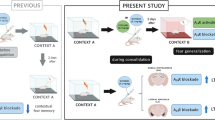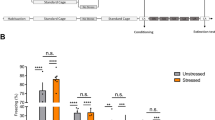Abstract
Rationale
Contextual fear conditioning can produce both changes in hippocampal synaptic efficacy and potentiation of subsequent fear learning.
Objectives
In this study, we tested whether fluoxetine reverses these effects.
Materials and methods
In the first experiment, we examined alterations of baseline synaptic efficacy and induction of synaptic plasticity in the CA3 region of the hippocampus during re-exposure of rats, treated with fluoxetine (7 mg/kg) or vehicle, in a context where they previously received 15 eyelid shocks or no shock (controls). In the second experiment, fear learning potentiation was examined in rats that were initially submitted to conditioning (15 eyelid shocks) and extinction training and then re-exposed to a less intense stressor (three eyelid shocks).
Results
Conditioned fear stress decreased synaptic efficacy and blocked the induction of synaptic potentiation in the fimbria–CA3 pathway. Conditioned rats treated with fluoxetine were protected against these electrophysiological changes and did not differ from controls (i.e., no depression and normal induction of potentiation of synaptic efficacy). However, fluoxetine treatment did not suppress conditioned freezing. After fear extinction, exposure of rats to a subconditioning stressor provoked conditioning (fear learning potentiation) in rats treated with vehicle but not in those treated with fluoxetine.
Conclusions
These findings indicate that fluoxetine treatment, which is ineffective on conditioned fear stress-induced freezing, may have beneficial effects on conditioned fear stress-induced disturbance of hippocampal plasticity. These data also suggest that restoration of hippocampal functioning may contribute to protection against exaggerated reactions to mild stressors reported in patients with post-traumatic stress disorder.



Similar content being viewed by others
References
Astur RS, St Germain SA, Tolin D, Ford J, Russell D, Stevens M (2006) Hippocampus function predicts severity of post-traumatic stress disorder. Cyberpsychol Behav 9:234–240
Blanchard RJ, Blanchard C (1969) Crouching as an index of fear. J Comp Physiol Psychol 6:370–375
Bremner JD, Krystal JH, Southwick SM, Charney DS (1995) Functional neuroanatomical correlates of the effects of stress on memory. J Trauma Stress 8:527–553
Cavazzuti E, Bertolini A, Vergoni AV, Arletti R, Poggioli R, Forgione A, Benelli A (1999) l-Sulpiride, at a low, non-neuroleptic dose, prevents conditioned fear stress-induced freezing behavior in rats. Psychopharmacology (Berl) 143:20–23
Dykman RA, Ackerman PT, Newton JEO (1997) Posttraumatic stress disorder: a sensitization reaction. Integr Physiol Behav Sci 32:9–18
Fanselow MS, DeCola JP, Young SL (1993) Mechanisms responsible for reduced contextual conditioning with massed unsignaled unconditional stimuli. J Exp Psychol Anim Behav Process 19:121–137
Garcia R, Jaffard R (1996) Changes in synaptic excitability in the lateral septum associated with contextual and auditory fear conditioning in mice. Eur J Neurosci 8:809–815
Garcia R, Vouimba RM, Jaffard R (1997) Contextual conditioned fear blocks the induction but not the maintenance of lateral septal LTP in behaving mice. J Neurophysiol 78:76–81
Garcia R, Tocco G, Baudry M, Thompson RF (1998) Exposure to a conditioned aversive environment interferes with the induction of LTP in the fimbria–CA3 pathway. Neuroscience 82:139–145
Hugues S, Kessal K, Hunt MJ, Garcia R (2003) A conditioned stressful environment causes short-term metaplastic-like changes in the rat nucleus accumbens. J Neurophysiol 90:3224–3231
Kessal K, Deschaux O, Chessel A, Xu L, Moreau JL, Garcia R (2006) Fluoxetine reverses stress-induced fimbria-prefrontal LTP facilitation. Neuroreport 17:319–322
Kim JJ, Fanselow MS (1992) Modality-specific retrograde amnesia of fear. Science 256:675–677
Kim EJ, Kim WR, Chi SE, Lee KH, Park EH, Chae JH, Park SK, Kim HT, Choi JS (2006) Repetitive transcranial magnetic stimulation protects hippocampal plasticity in an animal model of depression. Neurosci Lett 405:79–83
Rau V, DeCola JP, Fanselow MS (2005) Stress-induced enhancement of fear learning: an animal model of posttraumatic stress disorder. Neurosci Biobehav Rev 29:1207–1223
Rauch SL, Shin LM, Phelps EA (2006) Neurocircuitry models of posttraumatic stress disorder and extinction: human neuroimaging research—past, present, and future. Biol Psychiatry 60:376–382
Rocher C, Spedding M, Munoz C, Jay TM (2004) Acute stress-induced changes in hippocampal/prefrontal circuits in rats: effects of antidepressants. Cereb Cortex 14:224–229
Shin LM, Rauch SL, Pitman RK (2006) Amygdala, medial prefrontal cortex, and hippocampal function in PTSD. Ann NY Acad Sci 1071:67–79
Siegmund A, Wotjak CT (2007) A mouse model of posttraumatic stress disorder that distinguishes between conditioned and sensitised fear. J Psychiatr Res 41:848–860
Stewart CA, Reid IC (2000) Repeated ECS and fluoxetine administration have equivalent effects on hippocampal synaptic plasticity. Psychopharmacology (Berl) 148:217–223
Wu Z, Desmond NL, Levy WB (1998) Homosynaptic long-term depression of CA3–CA3 synapses in the in vivo hippocampus. Brain Res 789:335–338
Acknowledgements
This study was supported by the Neuro3d (CM) and by the University of Nice-Sophia Antipolis (GS, CZ, RG). We thank Dr. SI Wiener for his critical review of this manuscript.
Author information
Authors and Affiliations
Corresponding author
Rights and permissions
About this article
Cite this article
Spennato, G., Zerbib, C., Mondadori, C. et al. Fluoxetine protects hippocampal plasticity during conditioned fear stress and prevents fear learning potentiation. Psychopharmacology 196, 583–589 (2008). https://doi.org/10.1007/s00213-007-0993-7
Received:
Accepted:
Published:
Issue Date:
DOI: https://doi.org/10.1007/s00213-007-0993-7




